Please Take Note: This is a review of the final game, but it might change slightly based on the success of the Kickstarter campaign. The game is being reviewed on the components and the rules provided with the understanding that “what you see is not what you might get” when the game is published. If you like what you read and want to learn more, we encourage you to visit the game’s web page or visit the Kickstarter campaign. Now that we have all that disclaimer junk out of the way, on with the review!
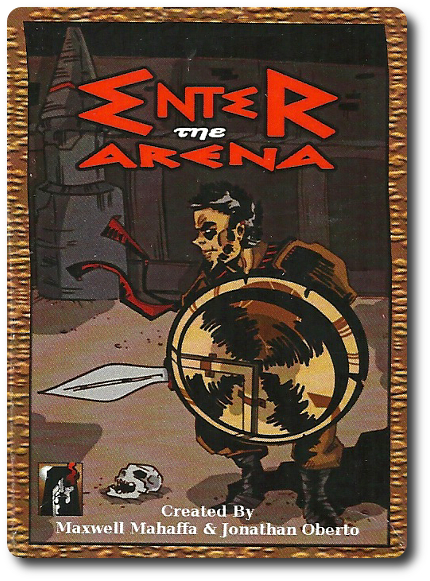
The Basics:
- For ages 9 and up (publisher suggests 13+)
- For 2 to 4 players
- Approximately 20 minutes to complete
Geek Skills:
- Counting & Math
- Logical & Critical Decision Making
- Strategy & Tactics
- Hand/Resource Management
Learning Curve:
- Child – Easy
- Adult – Easy
Theme & Narrative:
- Enter the arena to fight for glory and survival!
Endorsements:
- Gamer Geek approved!
- Parent Geek mixed!
- Child Geek mixed!
Overview
Spectators say it’s the roar of the crowd that drives the combatants into bloody rages. Scholars suggests that the brutality of man comes from the will to survive at all costs. Whatever the reason, death reigns supreme in the arena. Blood cakes the sand and the crowds scream in excitement and horror. You are now in the middle of the arena and it’s time to put on a show. Fight well and you might yet live to see the sunset.
Enter the Arena, designed by Maxwell Mahaffa, Jonathan Oberto, and to be published by Promethean Games, will reportedly be comprised of 1 Round Leader token, 30 Prowess cards, 12 Attack cards, 12 Defense cards, 8 Style cards, and 8 Instructional cards for a total of 70 cards. As this is a review of a prepublished game, we will not comment on the game component quality. Nor can we suggest that the game is complete, as the total game component count might change based on funding goal achievements. Not included in the game, but necessary to play, is some sort of method to keep track of individual players’ Health and Style points. We suggest you use a 20-sided die and a 12-sided die per player. A pen or pencil and a paper will also work, but is not as geeky.
Welcome to the Arena
To set up the game, first separate the Attack, Defense, Prowess, and Style cards into different decks.
Second, give each player a set of Attack, Defense, and Style cards. A set of Attack cards consists of one “1 Point”, one “2 Point”, and one “3 Point” Attack cards. A set of Defense cards consists of one “1 Point”, one “2 Point”, and one “3 Point” Defense cards. A set of Style cards consists of one “1 Point” and one “2 Point” Style cards. Any Attack, Defense, and Style cards not used are out for the duration of the game. The cards given to each player are referred to as the “player’s deck”. Players should pick up their deck of cards, but keep them hidden from their opponents at all times.
Third, shuffle the Prowess cards and place them face-down in the middle of the playing area.
Fourth, set each player’s starting Health point value. The number of starting Health points is based on the number of players at the table. A two-player game starts each player with 12 Health points, a 3-player game starts each player with 14 Health points, and a 4-player game starts each player with 16 Health points. Again, use a piece of paper or dice to keep track of these point values.
That’s it for game set up. Determine who will go first and give them the Round Leader token (we were given a card, which is shown below).
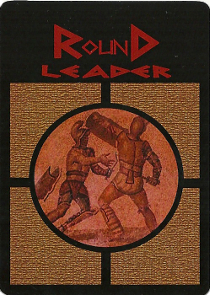
Let the battle begin!
Live by the Shield, Die by the Sword
Enter the Arena is played in rounds with no set number of rounds per game. A single round has 5 phases and always begins with the player who has the Round Leader token. Play then continues in turn order sequence around the table for each of the phases. These phases are summarized here.
Phase 1: Play Cards
Starting with the Round Leader, each player will select an Attack or Defense card of any value and place it in front of them, face-down. If the player places an Attack card (represented by weapons), they will be able to attack 1 opponent this round. If the player places a Defense card (represented by shields), they will be defending against all attacks that might target them this round. The number value (1 through 3) determines the default strength of the attack or the defense.
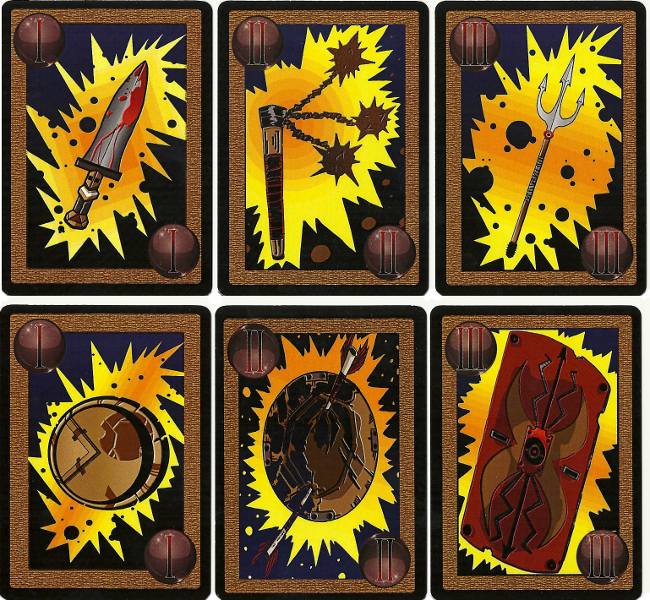
Phase 2: Flip Cards and Add Style
Starting with the Round Leader, each player will now reveal their played Attack or Defense card by flipping it over. If the player placed an Attack card, they must now state which player is their target AND if they are going to play a Style card. If the player placed a Defense card, they only need to decide if they want to play a Style card. Style cards are worth either 1 or 2 points and are played face-up to the table when the player reveals their Attack or Defense card.

Style cards do not increase Attack or Defense values. Instead, the Style card determines how many Style points the player will obtain if they successfully attack their target or successfully avoid damage during the round.
Phase 3: Play and Resolve Prowess Cards
Starting with the Round Leader, each player can play 1 Prowess card to the table, face-up, or pass. If they pass, they cannot play any other Prowess cards for the duration of the round. If they do elect to play a Prowess card, they may play another Prowess card again in turn order sequence. Effects from Prowess cards are assigned as soon as they are played, but are not yet resolved during this phase.
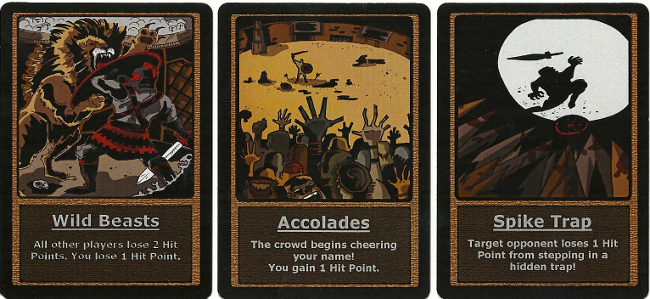
Prowess cards can affect one or all players in the game. Sometimes positively, but most often negatively. Each Prowess card describes how it’s used and can tip the balance in a seemingly hopeless battle.
This phase continues until all the players elect to pass.
Phase 4: Resolve Cards
- If the player attacked, they take the point value of the Attack card and modify with any Prowess cards in play that affect the player. This is the player’s Attack value for the round.
- If the player defended, they take the point value of the Defense card and modify with any Prowess cards in play that affect the player. This is the player’s Defense value for the round.
Players who attacked now subtract their target’s total Defense value from their total Attack value. If the resulting value is 1 or higher, the player has successfully attacked the target and the target reduces their total Health points by the resulting difference. For example, if a player’s total Attack value was a “3” and their target’s total Defense value was a “1”, the difference would be “2” (Attack of 3 – Defense of 1 = Difference of 2). The target than reduces their Health points by 2. Of course, if the target did not use a Defense card this round, all attacks against them automatically succeed and do full damage.
Players now determine if they collect any Style points based on the outcome of the round. If an attacking player successfully damaged their target, they gain 1 or 2 Style points based on the Style card they played for the round. If a defending player successfully blocked damage from an attack that targeted them, they gain 1 or 2 Style points based on the Style card they played for the round. Note that any damage received from a Prowess card does not prevent Style points.
Players can also steal an opponent’s Style points during a round. If a player who attacks successfully damages a player who is defending with Style, the attacking player gets the Style points their opponent played. If a player who is defending successfully blocks damage from an attack with Style, the defending player gets the Style points their opponent played. The stolen Style point are added to any Style points the player also earned this round.
Once the player determines how many Style points they earned this round, they add the value to their total number of Style points earned so far in the game. If the player earned any number of Style points, they draw 1 Prowess card and add it to their hand. This Prowess card can be used during the next round.
Any Prowess cards not yet resolved are now triggered and Health points are adjusted accordingly.
Phase 5: Change Round Leader
The round is now over. If no player has obtained victory, the next round begins. Any player who now has zero or less Health points is out for the duration of the game. All Prowess cards played are discarded. All Style cards are returned to their owning player. All Attack and Defense cards played this round are set aside and cannot be used again until all the players have played their Attack and Defense cards (6 rounds in total). Played Attack and Defense cards should be placed face-down to the side of the playing area so as not to be confused with cards played during subsequent rounds.
Lastly, the Round Leader token is passed to the next player in turn order sequence.
Victory or Death
The game continues until only one player is left (having vanquished all their opponents in brutal combat) or one of the players has obtained 12 or more Style points. If there is ever a Style point tie between 2 or more players, the player who has the most Health breaks the tie and wins the game. Again, use a piece of paper or dice to keep track of these point values.
To learn more about Enter the Arena, visit the game’s web page or visit the Kickstarter campaign.
Prediction
Enter the Arena is going to cause some problems for our younger Child Geeks. Any game that allows a player to specifically be targeted by another tends to really upset those Child Geeks who are still strengthening their emotional coping skills. This is especially true if they feel picked on. However, the game publishers are suggesting the game is for players ages 13 and up. While the game’s theme is violent in nature and a few of the cards portray acts of bloody violence, there is nothing about the game that would suggest this couldn’t be played by a Child Geek as young as 6 or 7-years-old. All that is needed is the ability to read. Any and all math can be done by other players or assistance can be provided as necessary. I predict a mixed endorsement, at best.
The Parent Geeks might also be a bit mixed on this. While the game is casual and there is more than enough depth of game play to keep them involved, but not overloaded, the game’s theme might not appeal to them. Combat games don’t really translate that well when playing with non-gamers and if the Child Geeks don’t like it, that will all but kill any chance of the game getting on the family table. There is hope, however, as many of our Parent Geeks also fancy themselves part-time Gamer Geeks (when time and children allow).
Which brings us to the Gamer Geeks who I believe will enjoy Enter the Arena. This is not a mindless card game. Timing is very important, hand management is a must, and risk management is crucial to survival. This is not just a game about kicking butt. There is a need for subtly and finesse. You could beat your opponent down, but the faster road to victory lies in simply being the smarter fighter, not the deadliest. While the card game is casual, I think the Gamer Geeks will find it to be an excellent addition to their gaming table when a lighter game is required to keep their hands occupied.
Teaching Enter the Arena is exceedingly simple. Honestly, you’ve spent more time and energy reading the review than what you’ll need to teach the game. Everyone starts with the same cards and each round allows the player to select which card they want to use. Just make certain all the players realize that once a card is played, it’s lost. A quick explanation of Style points and the Prowess cards should be all that is needed, even for the non-gamers.
Since Enter the Arena does require its players to keep their cards hidden and to read each card’s effects, my 3 and 6-year-old have opted to either observe or participate with another player as a team. My 9-year-old is more than capable of playing this game, and after teaching it to him, I asked him his thoughts on Enter the Arena so far.
“Really cool looking card game. I like how I get to decide what I do every round and then get to adjust how I attack you for points.” ~ Liam (age 9)
Looks like he’s ready to go. Let’s unsheathe our swords, heft our shields, and attack this game with a bloody geek roar! Which, as you can imagine, isn’t very intimidating…
Final Word
I want to make it clear that we are only counting the votes for our Child Geeks who are within or very close to the minimum age for the game. It would be faulty to suggest a game’s endorsement based off the votes of Child Geeks who are well below the game’s specified age range. However, if the Child Geek demonstrated a strong grasp of the game and played it without issue, we counted their votes. As such, we counted the votes of Child Geeks as young as 9-years-old who played the game very well. As expected, some of the Child Geeks felt picked on and there were a few bouts of frustration that resulted in Child Geeks leaving the table. No one left in tears, but the tension in the air at times was a bit too much for our younger Child Geeks to handle. When the games were done, the Child Geeks were split when it came to the endorsement. Those in favor of the game enjoyed how fast it was and how much fun it could be to attack each other in the game. Those who did not like the game thought it was too aggressive at times and unbalanced (because they kept losing). According to one Child Geek, who I thought summed it up nicely, “If you don’t like being attacked, you shouldn’t be playing a game that uses swords and shields.”
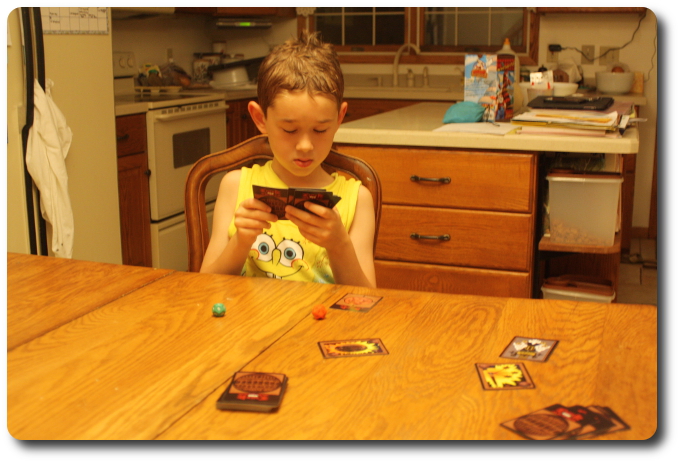
My little geek carefully considers his next move in the arena!
The Parent Geeks were also mixed. A number of them found the game to be a lot of fun, but couldn’t imagine playing it with their peers. Other Parent Geeks thought they had finally found a card game they could stomach to play with the in-laws. A number of the Parent Geeks didn’t care for the theme of the game and found a few of the card illustrations to be a bit too graphic. Also, as expected, if their Child Geeks were frustrated by the game, the non-gamers and very casual Parent Geeks didn’t give Enter the Arena their vote for approval. “Why bother?” asked one Parent Geek. True. If a Parent Geek is only looking for games that could be played with the family, Enter the Arena is not what many would consider a “family game”. But according to one Parent Geek, “This is a great card game! It’s strategic! It’s tactical! It’s fun! I’d play this again and again with my kids.”
Gamer Geeks, as expected, enjoyed the game. Of course, they took it to a whole new competitive level and the loud shouts of smack talk in the air were only slightly louder than the curses. All the Gamer Geeks were a bit skeptical at first when they saw the Attack and Defense cards, but quickly understood how Style cards, Style points, and Prowess cards were keys to victory. One Gamer Geek said, “This isn’t a game about mindless combat. You have to think through each sword swing and every raised shield.” Another Gamer Geek said, “Gods, this is a light game, but it would be perfect for lunch breaks, at the bar, or playing when waiting for others to show up.” All the Gamer Geeks agreed it was a “pretty good card game” and gave it their approval.
If Enter the Arena was only focused on attacking and defending, then I would not be interested in it whatsoever. It would be nothing more than a themed version of the traditional card game of War. With the addition of Style cards and points, players are able to use their cards to gain advantages. I like this as it introduces some interesting tactics when playing cards and basic hand management. Throw in the Prowess cards, which are essentially random trophies for those players clever enough to gain Style points, and you now have one more level of interesting play. Taking risks really pays off if you can play your cards right.
I very much enjoyed the game, but highly recommend everyone play it with 3 or 4 players. A 2-player game is too predictable and not that exciting or interesting. The best number of players is 4, in my opinion, as each player really has to watch their opponent and do what they can to attack at just the right time. Excellent stuff and a surprisingly deep level of thought is necessary to win. You need to take a moment to stop and attempt to read the other players, try to remember the cards already played, and then risk pushing the limits to get the advantage. I like games like this that seem small and simplistic but then quickly teach you that looks can be deceiving. Big games can come in small packages. Enter the Arena is a good card game that will challenge any player, be they Child, Parent, or Gamer Geek.
This is a paid for review of the game’s final prototype. Although our time and focus was financially compensated, our words are our own. We’d need at least 10 million dollars before we started saying what other people wanted. Such is the statuesque and legendary integrity of Father Geek which cannot be bought except by those who own their own private islands and small countries.




This game looks crazy fun and actually quite unique, love the art, i like that this is a card game set in a historical setting, instead of the same regurgitated fantasy stuff.
Yes, the gladiatorial arena is a nice change, but I’m starting to see it pop up more and more nowadays. I fear “gladiators” might be becoming the new “zombies”.
Thanks for taking the time to read the review and to leave a comment!
nice review aaaaaaaaaannnddddddd…Funded! cant wait to play
I’m pleased to hear our review was informative. I’m sorry about the hit to your banking account…
Great review, im thinking of getting this game for my two nephews, ages 8 and 10, i know that in the review it said some of the cards are gory, but the ones shown look like comic books, are the gory ones too graphic to post im wondering. I know kids see a lot worse in other medias, and the kids are becoming history buffs, so i thought this could be a nice “educational game” without them knowing it. Also in looking at the kickstarter, which tier do you think is the best bang for my buck, thank you
-S.
Most welcome, and thanks for taking the time to read our review.
“Too gory for my child” is a highly subjective statement and each Parent Geek must determine the level of appropriateness for themselves. I had no problem playing the game with my oldest little geek and my two youngest little geeks didn’t say much about the cards when they looked through them. Only a few of the Parent Geeks thought some of the cards were a bit too graphic, but that is a personal statement from them.
I didn’t post what other Parent Geeks thought were too gory because the game is not yet published. I have no idea if the artwork I was presented was the final version. If the game was finalized, I most certainly would.
But if specifics are being requested…
There isn’t much in the game that I would consider “historical”. It might have some historically based themes or game elements that derive from historical events, but the game itself is about battling each other while attempting to out-read and outmaneuver your opponent through smart card plays. The thematic element is up front thanks to the illustrations and the narrative element is further reinforced with the Prowess cards. But that’s it. Don’t expect to be learning anything about Gladiators or the arenas they fought in while playing this game. At most, a child will learn that becoming a Gladiator is a bad career choice.
If the game sounds interesting, be sure to buy it if you have the funds, but I’m not suggesting you do or don’t. I don’t want people going off and buying games just because I like it. I’d rather educate and then send you off to get another opinion. Mine shouldn’t be the only one you listen to, especially when it comes to your money.